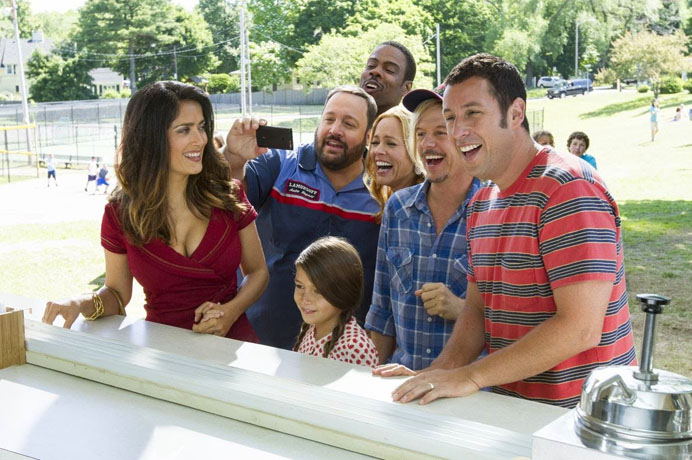
Grown Ups 2 (2013)
Directed by Dennis Dugan
Written by Fred Wolf & Adam Sandler & Tim Herlihy
101 min.
In 2010, Adam Sandler and his band of merry men released Grown Ups, a film that I felt, at the time, wasn’t good by any stretch of the imagination. I couldn’t understand why they chose the jokes they did, why they acted as if their actions had no real consequence from one scene to the next, and why the characters, when they weren’t at their absolute broadest, began to meld into one another to form just one character. I chalked it up to a case of bad movie syndrome.
Catching up with it on television, coming into the film at various points, it slowly began appealing to me. And then one day, while splitting my time between watching it with the sound down and reading, I realized why. The film is like a silent comedy, not like those told through space like in Buster Keaton pictures, or through pathos and character like Charlie Chaplin, but those told through time, like that of the great Mack Sennett and his band of merry men (namely the Keystone Cops). If you watch Grown Ups with the sound turned off while reading a book of jokes, it amounts to the same thing as with sound, except you can always refresh the jokes.
Its sequel, the imaginatively titled Grown Ups 2, is without a doubt obsessed with the idea of space (progressing from Sennett to Keaton). For instance, the film opens with a moose running amuck in Sandler’s mansion, which seems to happen only to give us a remarkable (for this day in age) view of the layout of the Sandler’s home and personal space.
Grown Ups 2, like the last couple of Sandler flicks, seems incredibly mean spirited, but that’s only at first glance. It only seems this way if the characters are seen as characters (as most modern audiences will view them) instead of what they truly are: markers of space or avatars we use to explore that space. The sole purpose of David Spade rolling around through town in a giant tire is to show us the characters in said town (markers of narrative space) that we have seen previously or will see again by the end of the picture. Characters turn into cartoons—figuratively, like in any Sandler flick, or literally, by turning into CGI. The film is certainly more concerned with how far Shaq can throw someone than why he is throwing them—and is Shaq’s throwing victim really considered a character if he is obviously just a bad CGI job? How about when a character’s hopes are dashed, or they are put down as a loser/coward/transvestite/closeted homosexual? The film undercuts any sentimentality that can usually arise from these kinds of situations, and for that I admire it.
This obsession with space is only emphasized by its blatant disregard for time. Unlike the first film, there are no flashbacks, which were the cornerstone of the original. In that film, characters would literally change into their younger selves to show how each set (young and old) reacted to situations—ultimately showing how little has changed. Coupled with the vast amounts of “remember that time” lines, these examples show change as something that is minimal or ineffective.
The sequel has zero interest in change, or even time. The examples of time in the film come with a certain contempt. The film takes place on the last day of school, but for David Spade’s son, it’s the first day of school. When Sandler is criticized about being from Hollywood, he responds by saying “I’ve lived in this town for what, ten months?” (the “what” being the operative word, as he seems to have no idea how long he’s been there and maneuvers through the space and characters as if he’s been there forever). Chris Rock, in an elaborate scheme to screw with his mother-in-law, keeps leaving a note on her door saying he’s coming to fix her cable tomorrow between 8AM and 4PM, a note he’s been leaving on her door every single day, and it seems, will keep leaving for eternity. The characters come to the decision to throw an 80’s themed party all at once, in different spaces, all at the exact same time: a message created, delivered, and received instantaneously across vast spaces. The party that is thrown seems like it really does take place in the 80‘s—even the J. Geils Band plays in Sandler’s back yard (and they appear magically, as if they arrived through a rift in time).
The space that this film exists in achieves a harmony that would be undone were any importance placed on time. In fact, the town could be called Sandlerville—an alternate universe that a fan of his may deem to be the perfect town, populated by all the supporting characters we know and love from the rest of his films, with all of them more or less playing themselves (Nick Swardson plays Nick and the mighty Peter Dante plays Officer Peter Dante). There is no inside or outside to these characters—only up, down, left, right, back, forward. And for this film, that is enough. It follows its own special design, which is actually more sophisticated than most of the films I’ve seen these past couple years that wallow in extremely close shots that jump around with pointless edits, avoiding the world with an intense fear of space. I’d rather spend a few minutes in Sandlerville, and that can be for 5 minutes or 90—time doesn’t exist there anyway.